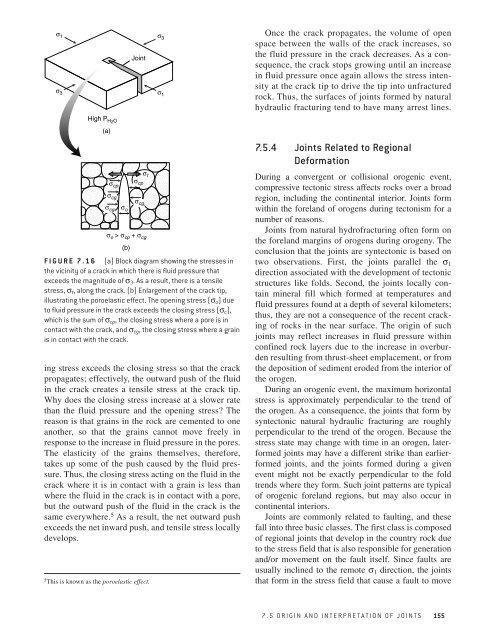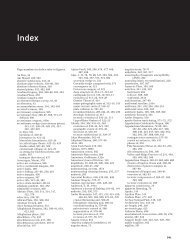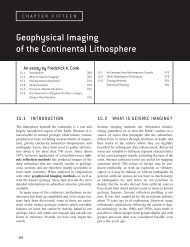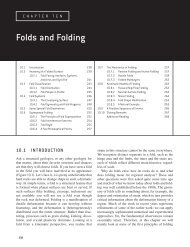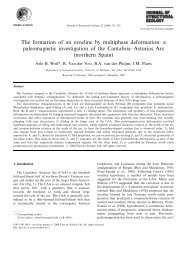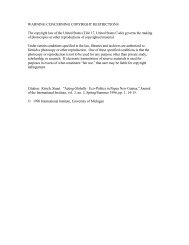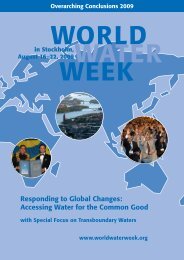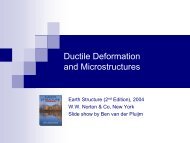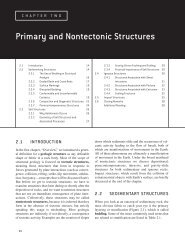Joints and Veins - Global Change
Joints and Veins - Global Change
Joints and Veins - Global Change
- No tags were found...
You also want an ePaper? Increase the reach of your titles
YUMPU automatically turns print PDFs into web optimized ePapers that Google loves.
2917-CH07.pdf 11/20/03 5:11 PM Page 155σ 1 σ 3Jointσ 3σ 1Once the crack propagates, the volume of openspace between the walls of the crack increases, sothe fluid pressure in the crack decreases. As a consequence,the crack stops growing until an increasein fluid pressure once again allows the stress intensityat the crack tip to drive the tip into unfracturedrock. Thus, the surfaces of joints formed by naturalhydraulic fracturing tend to have many arrest lines.High P H2 O(a)σ cpσ cgσ cgσ oσ cpσ cging stress exceeds the closing stress so that the crackpropagates; effectively, the outward push of the fluidin the crack creates a tensile stress at the crack tip.Why does the closing stress increase at a slower ratethan the fluid pressure <strong>and</strong> the opening stress? Thereason is that grains in the rock are cemented to oneanother, so that the grains cannot move freely inresponse to the increase in fluid pressure in the pores.The elasticity of the grains themselves, therefore,takes up some of the push caused by the fluid pressure.Thus, the closing stress acting on the fluid in thecrack where it is in contact with a grain is less thanwhere the fluid in the crack is in contact with a pore,but the outward push of the fluid in the crack is thesame everywhere. 5 As a result, the net outward pushexceeds the net inward push, <strong>and</strong> tensile stress locallydevelops.σ tσ o > σ cp + σ cg(b)FIGURE 7.16 (a) Block diagram showing the stresses inthe vicinity of a crack in which there is fluid pressure thatexceeds the magnitude of σ 3 . As a result, there is a tensilestress, σ t , along the crack. (b) Enlargement of the crack tip,illustrating the poroelastic effect. The opening stress (σ o ) dueto fluid pressure in the crack exceeds the closing stress (σ c ),which is the sum of σ cp , the closing stress where a pore is incontact with the crack, <strong>and</strong> σ cg , the closing stress where a grainis in contact with the crack.5 This is known as the poroelastic effect.7.5.4 <strong>Joints</strong> Related to RegionalDeformationDuring a convergent or collisional orogenic event,compressive tectonic stress affects rocks over a broadregion, including the continental interior. <strong>Joints</strong> formwithin the forel<strong>and</strong> of orogens during tectonism for anumber of reasons.<strong>Joints</strong> from natural hydrofracturing often form onthe forel<strong>and</strong> margins of orogens during orogeny. Theconclusion that the joints are syntectonic is based ontwo observations. First, the joints parallel the σ 1direction associated with the development of tectonicstructures like folds. Second, the joints locally containmineral fill which formed at temperatures <strong>and</strong>fluid pressures found at a depth of several kilometers;thus, they are not a consequence of the recent crackingof rocks in the near surface. The origin of suchjoints may reflect increases in fluid pressure withinconfined rock layers due to the increase in overburdenresulting from thrust-sheet emplacement, or fromthe deposition of sediment eroded from the interior ofthe orogen.During an orogenic event, the maximum horizontalstress is approximately perpendicular to the trend ofthe orogen. As a consequence, the joints that form bysyntectonic natural hydraulic fracturing are roughlyperpendicular to the trend of the orogen. Because thestress state may change with time in an orogen, laterformedjoints may have a different strike than earlierformedjoints, <strong>and</strong> the joints formed during a givenevent might not be exactly perpendicular to the foldtrends where they form. Such joint patterns are typicalof orogenic forel<strong>and</strong> regions, but may also occur incontinental interiors.<strong>Joints</strong> are commonly related to faulting, <strong>and</strong> thesefall into three basic classes. The first class is composedof regional joints that develop in the country rock dueto the stress field that is also responsible for generation<strong>and</strong>/or movement on the fault itself. Since faults areusually inclined to the remote σ 1 direction, the jointsthat form in the stress field that cause a fault to move7.5 ORIGIN AND INTERPRETATION OF JOINTS155


